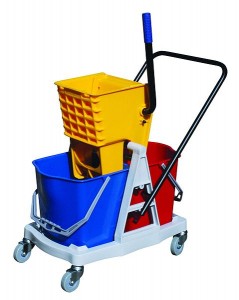
You might think that mop buckets haven’t changed much in the past 50 or 100 years and, for the most part, you would be right. They still work pretty much the same: A reservoir of water and mechanical wringer to remove excess liquid from the mop head.
But there have been some small, subtle changes that have made mop buckets significantly more efficient in recent years.
Sturdier Materials
For one thing, today’s mop buckets are made from sturdier, more durable materials. Most modern mop buckets are made from a combination of tubular steel frames and structural web molded plastic bodies.
Today’s mop buckets are designed to take more abuse than earlier models which were made of less durable aluminum or tin.
Increased Stability
Anyone who has mopped a floor knows that the worst thing that can happen is the mop bucket tipping over, spilling its dirty water all over the surface that has just been cleaned.
But that’s less of a problem with today’s better-designed mop buckets, which feature either attached casters or a modular removable wheel assembly that can be locked into place with a single twisting motion.
Size Matters
Mop buckets also now come in a variety of sizes, including massive capacity models that are built for the biggest industrial and commercial cleaning jobs.
Wringers also have improved. While they still remain pretty basic — a level and spring assembly attached to a couple of paddles — they are built to last longer. Some mop bucket models are tested to exceed 50,000 wring cycles, compared to traditional mop buckets which could only withstand up to 860 wring cycles.
Wave Brake Technology
But perhaps the most significant advancement are wave brakes that are now built into the molded plastic body of some modern mop buckets. These are simple half-walls that stop the water within the mop bucket from splashing out as easily.
In traditional mop buckets, it was necessary to use extreme caution when moving or rolling the mop bucket from one location to another. That’s because the liquid inside the bucket would easily splash out, potentially contaminating the recently cleaned surface.
But the wave brakes stop the liquid from splashing by up to 40%, making moving the mop bucket from one place to another simpler and messes less frequent.
High-Tech Mop Buckets
Some more advanced mop buckets have high-tech features, such as a foot pedal water release mechanism that allows for the bucket to be drained without lifting it — an ergonomic feature that reduces back strain on workers.
Other models feature built-in water cleaning system that use filters to cleanse the liquid within the mop bucket, cutting down on the frequency of changing the dirty water. There’s also a spin dry mop that uses centrifugal force to remove water from the mop.
While these developments may indicate where mop bucket technology is going in the future, the more recent widespread advancements have made an ordinary task like mopping a floor simpler and more efficient.
